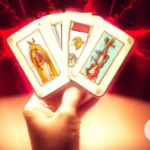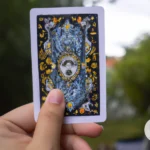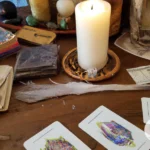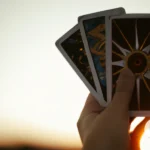Human beings have been fascinated by their dreams since ancient times. Dreams have been interpreted as messages from the divine, glimpses of the future, and reflections of our own inner workings. Tarot cards have similarly captivated people for centuries with their mysterious symbolism and potential for divination. But can these two practices be combined to unlock the secrets of our dreams? In this article, we will explore the world of dream interpretation with tarot cards. From understanding the basics of tarot to interpreting specific dream symbols, we will provide step-by-step guidance to help you tap into the hidden meanings of your dreams. So, if you’re ready to explore the fascinating world of tarot and dreams, let’s get started!
Understanding Tarot Cards
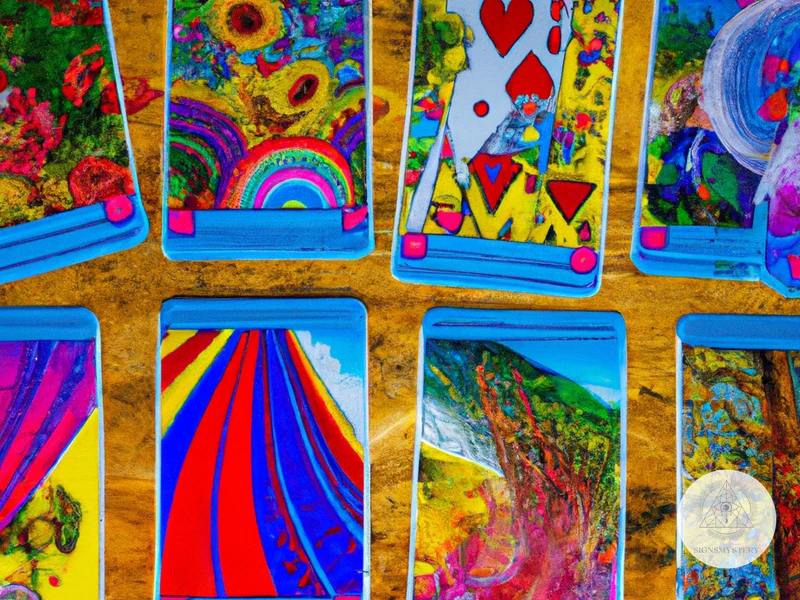
Tarot cards have been used for centuries to provide insight and guidance in various aspects of life, including dream interpretation. is crucial to unlock their secrets and use them effectively to decode your dreams. Tarot cards are a deck of 78 cards divided into Major Arcana and Minor Arcana, each with its own unique symbolism and meanings. Major Arcana cards represent major life events and spiritual messages, while Minor Arcana cards signify daily life events and challenges. To use Tarot Cards for dream interpretation, you need to know the interpretation of each card, how to choose the right deck, how to prepare it for dream interpretation, how to shuffle the cards, and finally, which layouts to use for different types of dreams. With a little practice, using Tarot Cards can help you understand and decode the hidden messages within your dreams.
What are Tarot Cards?
Tarot cards are a deck of 78 cards used for divination, guidance, and gaining insight into the past, present, and future. Each card has its own unique meaning, symbolism, and interpretation, giving the tarot deck a depth and complexity mired by mysticism and intrigue. Tarot cards can be divided into two categories, the Major Arcana and Minor Arcana. The Major Arcana consists of 22 cards, each representing a significant archetypal character or theme, while the Minor Arcana consists of 56 cards divided into four suits – Cups, Wands, Swords, and Pentacles – each representing various aspects of life such as emotions, career, relationships, and material possessions.
There are different theories as to the origins of tarot cards, but most historians agree that they were created in the 15th century in Italy as a playing card game for the upper class. Over time, the cards began to be used for divination and spiritual purposes, and their popularity quickly spread throughout Europe and later worldwide. Today, tarot cards are a tool for personal growth, self-discovery, and understanding the subconscious mind.
Understanding the symbolism and meaning behind each card is key to unlocking the secrets of your dreams and interpreting them with tarot cards. By using the cards as a visual aid, you can uncover hidden meanings, gain clarity, and tap into your intuition. In the next section, we’ll explore how tarot cards can be used to interpret dreams. If you want to know what the Major Arcana or the Minor Arcana mean in dreams, check out our articles on Major Arcana Meanings in Dreams and Minor Arcana Meanings in Dreams.
How do Tarot Cards Work?
Tarot cards are believed to work by tapping into the energies and vibrations of the universe. When you shuffle the cards, you are effectively mixing up these energies before drawing them out and interpreting their messages. Each card in a tarot deck has a specific meaning, and when combined with other cards, creates a narrative or story. Tarot cards work by accessing the subconscious mind, helping you gain insights into your current life situation, past, present, and future. They offer a way to explore your deepest desires, fears, and hopes using symbolism and archetypes. Tarot readers believe that the cards are a tool that can help people connect with their higher selves and spiritual guides, as well as unlock hidden knowledge about themselves and the world around them. By focusing on your specific question or intention, tarot cards can provide guidance on making decisions, illuminating blind spots, and uncovering the underlying energies and influences shaping your life. To learn more about tarot card interpretation, check out our guide here. To explore how tarot cards can help interpret specific dream symbols, head over to our article on dream symbols and tarot.
Interpreting Dreams with Tarot Cards
Unlocking the secrets of your dreams with tarot cards can be a perplexing yet rewarding experience. Interpreting dreams with tarot cards involves understanding the symbols and meanings behind the images that come up in your dreams. Choosing the right deck, preparing it for dream interpretation, shuffling the cards, and laying them out in a specific layout are important steps to follow. However, the most important step is to have an open and receptive mindset. Tarot cards can help you gain insight and clarity into your dreams, but ultimately it is your intuition and personal interpretation that will guide you towards understanding the messages your dreams are trying to convey.
Choosing the Right Deck
When it comes to unlocking the secrets of your dreams using Tarot cards, choosing the right deck is a crucial step. With so many options available, it can be challenging to know where to start. Your intuition plays a significant role here, but there are a few things to consider before you make a purchase.
Symbolism: Different decks feature various symbolism, which may resonate more with you than others. For example, the Rider-Waite deck is a popular choice, known for its intricate and detailed imagery. The Thoth deck, on the other hand, is more abstract and may appeal to those drawn to a more modern interpretation. Take some time to research the symbolism of the decks you are considering and see what speaks to you.
Intention: Think about your intention for using the deck. Are you looking to gain insight into your dreams, or do you plan on using the deck for divination purposes? Some Tarot decks may be better suited for one or the other. For example, the Wild Unknown is a popular deck for self-reflection and meditation, while the Crowley-Harris Thoth deck is often used for divination.
Size: The size of the deck is also a consideration to keep in mind. Do you plan on traveling with your deck, or will it mostly be used at home? A larger deck may be beautiful to look at, but it may not be practical to carry around with you. Conversely, a small deck may be easy to transport, but the cards may be too small to see details clearly.
Personal Connection: Ultimately, the most important factor in choosing a Tarot deck is your personal connection to it. Take some time to browse different decks and see which ones draw you in. Pay attention to how you feel when you look at the cards and the emotions they evoke. Trust your intuition and choose a deck that feels right for you.
By considering these factors, you can choose a Tarot deck that resonates with you and allows you to unlock the secrets of your dreams with confidence.
Preparing Your Deck for Dream Interpretation
Preparing your tarot deck for dream interpretation is an essential step to ensure the accuracy of your readings. Follow these tips to create a sacred space for your tarot cards and prepare them for dream interpretation:
- Clear your deck: Before using your tarot deck for dream interpretation, it is essential to clear any negative energy that may be attached to it. You can do this by placing your deck in a bag of sea salt or using a crystal, such as clear quartz, to cleanse the cards.
- Bless your deck: To establish a connection with your tarot cards, it is essential to bless them before use. You can do this by holding them in your hands and saying a prayer or setting a positive intention for their use.
- Meditate with your deck: Spending some time in quiet meditation with your tarot deck can help you establish a deeper connection with the cards and awaken your intuition.
- Keep your deck wrapped: When not in use, it is essential to keep your tarot deck wrapped in a silk cloth or bag to protect them from negative energy and enhance their energy vibration.
By following these simple steps, you can create a sacred space for your tarot deck and prepare it for dream interpretation. Remember to treat your tarot cards with love and respect, and they will serve as a valuable tool for unlocking the secrets of your dreams.
Shuffling the Cards
Shuffling the cards is an essential step in using tarot cards to interpret your dreams. There are various methods for shuffling tarot cards. Some people prefer to use the standard riffle shuffle, while others prefer to use a more intuitive method. One of the most popular shuffling techniques is the Hindu shuffle.
The Hindu shuffle involves holding the deck with your left hand (or non-dominant hand) and using your right hand to strip cards off the top of the deck into the palm of your left hand. This method allows for a more gentle shuffling of the cards, which can be beneficial for attuning to your intuition.
Another popular technique is the overhand shuffle, which involves taking small stacks of cards from the top of the deck and placing them onto the bottom. This method can be a bit more aggressive, but it allows for a quick and thorough mix of the cards.
Whichever shuffling method you choose, it’s important to focus on your intention while shuffling. You can also incorporate affirmations or mantras into your shuffling process to set the tone for your dream interpretation. For example, you might say “I am open to receiving insights and wisdom from my dreams” or “May these cards reveal the hidden truths of my subconscious mind.”
To further enhance your shuffling process, you can also incorporate cleansing rituals such as smudging the deck with sage or placing the cards under the light of the full moon. These practices can help clear any negative energy from the deck and create a more open and receptive energy for your dream interpretation.
Shuffling the cards is an important step in using tarot cards to unlock the secrets of your dreams. By setting your intention, using a shuffling method that resonates with you, and incorporating cleansing rituals, you can create a powerful and meaningful experience for interpreting your dreams.
Layouts for Dream Interpretation
When it comes to using tarot cards for dream interpretation, there are different layouts that you can use to help you gain deeper insights into your dreams. Here are some popular layouts that can help you unlock the secrets of your dreams with tarot cards:
1. Three-Card Layout: This is the simplest and most popular layout for dream interpretation. With this layout, you draw three cards to represent the past, present, and future of your dream. The first card represents the past, the second card represents the present, and the third card represents the future. You can use this layout if you want a quick and easy interpretation of your dream.
2. Celtic Cross Layout: This is a more complex layout that can give you a deeper understanding
Subscribe to Our Newsletter
Sign up to receive the latest news and updates.
3. Dream Journal Layout: With this layout, you draw one card for each of the major symbols or themes in your dream and journal about what each card means to you. This layout can help you explore your dreams on a deeper level and gain insights that you might have missed otherwise.
4. Astrological Layout: This layout uses astrology to help you interpret your dreams. With this layout, you draw one card for each of the twelve astrological houses and use them to interpret the different aspects of your dream. This layout can give you a unique perspective on your dream and help you understand it from a different angle.
Remember, these are just a few examples of the many layouts you can use to interpret your dreams with tarot cards. The key is to find a layout that works for you and to practice using it regularly. With time and practice, you can develop a deeper understanding of your dreams and unlock the secrets of your subconscious mind.
Interpreting Specific Dream Symbols
Dreams can be a mysterious and perplexing experience, often leaving us with more questions than answers. However, certain symbols within our dreams can hold significant meanings and insights into our subconscious thoughts and emotions. By using a tarot deck for dream interpretation, we can gain a deeper understanding of these symbols and their underlying messages. The Common Dream Symbols and their Meanings section of this article offers insight into the significance of common dream symbols such as flying, water, or animals. For a more personalized interpretation, the How to Use Tarot Cards to Interpret Specific Dreams section provides guidance on selecting the appropriate cards and layout to uncover the deeper meanings behind our dreams.
Common Dream Symbols and their Meanings
Dreams are often full of symbolism, and it can be challenging to interpret what they mean. Each person’s dreams may have unique symbolism to them, but there are some common dream symbols that tend to have similar interpretations.
One of the most common dream symbols is falling. Falling can signify a feeling of losing control or fear of failure. If you dream of falling, it may be a sign that you need to address these underlying issues in your waking life.
Another common dream symbol is flying. Dreaming of flying may represent freedom, liberation, or a sense of achievement. It can also indicate that you have a desire for escape from your current situation.
Teeth falling out is another common dream symbol that can be unsettling. It often signifies a loss of power or control, and it can indicate financial issues or difficulties with communication.
Water is also a prevalent dream symbol, and it can have many interpretations depending on the context. Calm water can symbolize a sense of peace, while turbulent water may represent emotional turmoil or uncertainty.
Other common dream symbols include nakedness, which can symbolize vulnerability or the need for honesty, and being chased, which may represent something or someone you are trying to avoid in your waking life.
When interpreting your dreams, it’s important to consider the context and personal associations you have with each symbol. But understanding these common dream symbols and their possible meanings can give you a starting point for understanding your dreams and their messages.
How to Use Tarot Cards to Interpret Specific Dreams
Using Tarot Cards to interpret specific dreams can be an effective way to gain insight and clarity into your subconscious mind. Here are some tips on how to use Tarot Cards for interpreting specific dreams:
1. Identify the symbols: Start by identifying the symbols in your dream. Look for recurring themes or symbols that stand out to you. Jot these down in a journal or on a piece of paper.
2. Choose the appropriate cards: Once you have identified the symbols in your dream, choose Tarot Cards that correspond to those symbols. For example, if you dream about water, you might choose the Suit of Cups in the Tarot deck.
3. Lay out the cards: Layout the chosen Tarot Cards in a spread that best represents your dream. You might choose a simple three-card spread or a more complex spread, depending on the complexity of your dream.
4. Interpret the cards: Each Tarot Card has its own meanings and interpretations. Refer to a Tarot guidebook or website to learn more about the meanings of each card. As you interpret the cards, think about how they relate to the symbols and themes in your dream.
5. Reflect on your interpretation: Once you have interpreted the Tarot Cards, take some time to reflect on the meaning and significance of your interpretation. Does it bring clarity or insight into your dream? What actions, if any, do you need to take based on your interpretation?
Using Tarot Cards to interpret specific dreams can provide a deeper understanding of the messages from your subconscious mind. However, it’s important to remember that Tarot Cards are one tool for interpreting dreams, and it’s up to you to determine their relevance and accuracy.
Conclusion
Conclusion:
In conclusion, unlocking the secrets of your dreams with tarot cards can be a powerful tool for gaining insight into your subconscious mind. By understanding the meanings of the cards and using them to interpret your dreams, you can tap into a wealth of knowledge about yourself, your emotions, and your waking life. Remember, interpreting dreams with tarot cards is a deeply personal process, and the insights you gain may not always be easy to confront. However, with practice and patience, you can develop a deeper understanding of yourself and your world.
To recap, here are the key points to keep in mind when using tarot cards for dream interpretation:
- Choose the right deck that resonates with you and your goals.
- Preparing your deck for dream interpretation by cleansing and energizing it.
- Shuffling the cards thoroughly to ensure a random draw.
- Using layouts that are specific to dream interpretation, such as the Dream Spread or the Dream Weaver Spread.
- Understanding common dream symbols and their meanings.
- Using the cards to interpret specific elements of your dreams.
Remember, the more you practice and engage in dream interpretation with tarot cards, the more skilled you will become at unlocking the secrets of your dreams. So get started today, and start exploring the rich inner world of your subconscious mind!
Frequently Asked Questions
1. Can Tarot Cards tell me my future?
No, Tarot Cards cannot predict your future with certainty. Instead, they provide guidance and insight into the current circumstances surrounding your question.
2. Is it necessary to be psychic to use Tarot Cards?
No, anyone can use Tarot Cards with practice and an open mind. It is not necessary to have psychic abilities.
3. Do I have to believe in Tarot to use it?
No, belief in Tarot is not necessary. However, having an open mind and approaching the cards with curiosity can lead to a more insightful reading.
4. How do I know which Tarot Deck to choose?
Choose a Tarot Deck that resonates with you visually and emotionally. Research the history and symbolism of the deck to ensure it aligns with your beliefs and intentions.
5. Can I use Tarot Cards to interpret dreams that are not mine?
Technically, yes. However, it is important to respect other people’s privacy and not delve into their private subconscious without their permission.
6. How often should I cleanse my Tarot Deck?
It is recommended to cleanse your Tarot Deck after each use, but also to intuitively cleanse it whenever you feel it needs it.
7. Can Tarot Cards be used for mental and emotional healing?
Yes, Tarot Cards can provide insight and guidance for mental and emotional healing. However, it is important to seek professional help for any serious or persistent issues.
8. What should I do if I receive a negative reading?
Use any negative cards or messages as a learning opportunity and a call to action. Reflect on the sources of negativity in your life and take steps to address them.
9. Can I use Tarot Cards for business decisions?
Yes, Tarot Cards can be a helpful tool for making business decisions. Use a spread that focuses on strategy or decision-making, and approach the reading with a clear and focused intention.
10. How long does it take to become proficient in Tarot?
It varies from person to person, but with consistent practice and study it is possible to become proficient in Tarot within a few months to a year.




